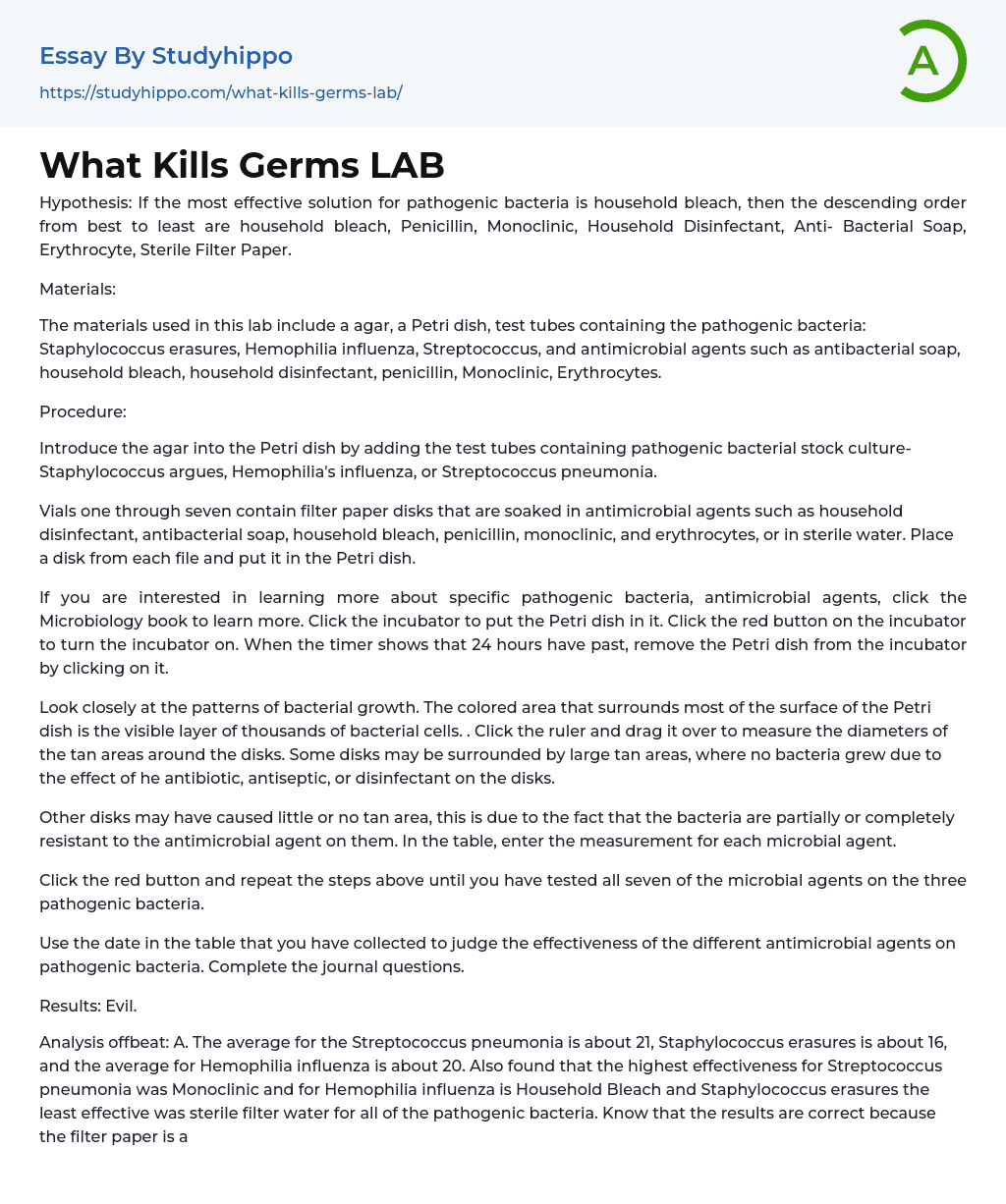Hypothesis: If the most effective solution for pathogenic bacteria is household bleach, then the descending order from best to least are household bleach, Penicillin, Monoclinic, Household Disinfectant, Anti- Bacterial Soap, Erythrocyte, Sterile Filter Paper.
Materials:
The materials used in this lab include a agar, a Petri dish, test tubes containing the pathogenic bacteria: Staphylococcus erasures, Hemophilia influenza, Streptococcus, and antimicrobial agents such as antibacterial soap, household bleach, household disinfectant, penicillin, Monoclinic, Erythrocytes.
Procedure:
Introduce the agar into the Petri dish by adding the test tubes containing pathogenic bacterial stock culture- Staphylococcus argues, Hemophilia's influenza, or Streptococcus pneumonia.
Vials one through seven contain filter paper disks that are soaked in antimicrobial agents such as household disinfectant, antibacterial soap,
...household bleach, penicillin, monoclinic, and erythrocytes, or in sterile water. Place a disk from each file and put it in the Petri dish.
If you are interested in learning more about specific pathogenic bacteria, antimicrobial agents, click the Microbiology book to learn more. Click the incubator to put the Petri dish in it. Click the red button on the incubator to turn the incubator on. When the timer shows that 24 hours have past, remove the Petri dish from the incubator by clicking on it.
Look closely at the patterns of bacterial growth. The colored area that surrounds most of the surface of the Petri dish is the visible layer of thousands of bacterial cells. . Click the ruler and drag it over to measure the diameters of the tan areas around the disks. Some disks may be surrounded by large tan areas, where no bacteria grew due to the effect of he antibiotic, antiseptic, or disinfectant on the disks.
Other disks may hav
caused little or no tan area, this is due to the fact that the bacteria are partially or completely resistant to the antimicrobial agent on them. In the table, enter the measurement for each microbial agent.
Click the red button and repeat the steps above until you have tested all seven of the microbial agents on the three pathogenic bacteria.
Use the date in the table that you have collected to judge the effectiveness of the different antimicrobial agents on pathogenic bacteria. Complete the journal questions.
Results: Evil.
Analysis offbeat: A. The average for the Streptococcus pneumonia is about 21, Staphylococcus erasures is about 16, and the average for Hemophilia influenza is about 20. Also found that the highest effectiveness for Streptococcus pneumonia was Monoclinic and for Hemophilia influenza is Household Bleach and Staphylococcus erasures the least effective was sterile filter water for all of the pathogenic bacteria. Know that the results are correct because the filter paper is always going to be the least effective because it has no chemicals, ND I know that the other highest effective antimicrobial agents have different effects on different substances by the data that was collected.
Conclusion: A.
I reject by hypothesis because the best solutions for pathogenic bacteria depend in what bacteria you are dealing with and what antimicrobial agents works the best for it.
I reject the hypothesis I stated because of the reasons I stated above but the data have to prove it is that for Streptococcus pneumonia the most effective antimicrobial is Monoclinic, but for Hemophilia influenza and for Staphylococcus erasures it is Household Bleach.
So that proves that for different pathogenic agents there are different solutions.
A lesson
I learned is that using only filter water to get something off my hand does not work as well as using soap and water.
Errors that could have occurred in the experiment is measuring errors when measuring where no bacteria has grown, another error that could have occurred is putting the data in the wrong box.
Questions:
The effects of the different antibiotic drugs differed in reactions. No, they were not as effective at controlling bacteria growth. In the lab when you tested the experiment the results showed that with some antibiotic drugs the bacterial growth grew instead of being contained.
For example Penicillin worked well when used to treat Hemophilia influenza and Streptococcus pneumonia but did not work well on Staphylococcus erasures, Monoclinic had a similar effect of these pathogenic bacteria. While Erythrocyte was different by working well on Staphylococcus erasures but not being good on Hemophilia influenza and Streptococcus pneumonia.
The chemical disinfectants were stronger than the regular household antibacterial drugs and a person may see this when they look at the big circle of inhibition of none bacterial growth.
- Bacteria essays
- Biotechnology essays
- Breeding essays
- Cell essays
- Cell Membrane essays
- Cystic Fibrosis essays
- Enzyme essays
- Human essays
- Microbiology essays
- Natural Selection essays
- Photosynthesis essays
- Plant essays
- Protein essays
- Stem Cell essays
- Viruses essays
- Apoptosis essays
- Asthma essays
- Black Death essays
- Breast Cancer essays
- Cholesterol essays
- Chronic essays
- Chronic Pain essays
- Death essays
- Diabetes essays
- Down Syndrome essays
- Epidemic essays
- Hypertension essays
- Infection essays
- Infertility essays
- Myocardial Infarction essays
- Pain essays
- Pathogen essays
- Pregnancy essays
- Sexually Transmitted Disease essays
- Symptom essays
- Tuskegee Syphilis Experiment essays
- Water supply essays




